|
The Enduring Charm of Currier &
Ives
by Bob Brooke
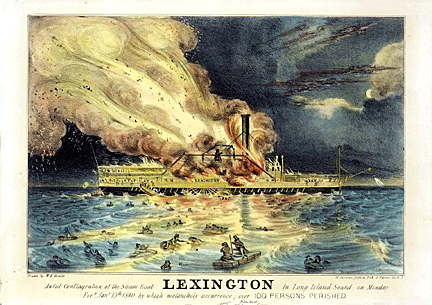 On
Jan. 13, 1840, the steamboat Lexington caught fire while en route
from New York to Stonington, Conn. Only a handful of the 140
passengers and crew survived. Three days later, a realistic picture
of the tragedy appeared in The. Extra Sun, a subsection of the New
York Sun.. Acknowledged to be the first published newspaper
illustration, the Awful Conflagration of the Steam Boat "Lexington"
in Long Island Sound made the firm of N. Currier an overnight
success. On
Jan. 13, 1840, the steamboat Lexington caught fire while en route
from New York to Stonington, Conn. Only a handful of the 140
passengers and crew survived. Three days later, a realistic picture
of the tragedy appeared in The. Extra Sun, a subsection of the New
York Sun.. Acknowledged to be the first published newspaper
illustration, the Awful Conflagration of the Steam Boat "Lexington"
in Long Island Sound made the firm of N. Currier an overnight
success.
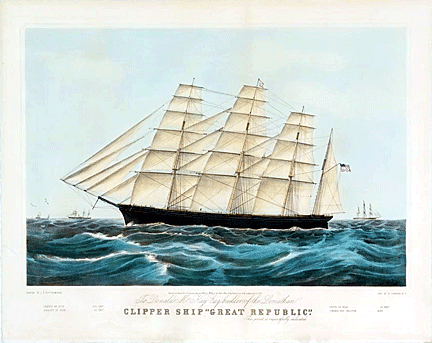 Probably
no other medium preserved life as it was in the 19th century as did
the faithful and colorful prints of Currier and Ives. From 1834 to
1907, their lithography shop produced in excess of one million
prints of American scenes, which included more than 7500 different
titles. They not only sold them successfully in great numbers to the
public, but left behind fond images that are highly collectible
today. Probably
no other medium preserved life as it was in the 19th century as did
the faithful and colorful prints of Currier and Ives. From 1834 to
1907, their lithography shop produced in excess of one million
prints of American scenes, which included more than 7500 different
titles. They not only sold them successfully in great numbers to the
public, but left behind fond images that are highly collectible
today.
The American middle class became the firm's primary audience. Their
prints stressed the wholesome things like "ships and trains,
animals,, architecture, current and historical events, and
particularly outdoor scenes.
Nathaniel Currier—Young Lithographer
At the age of 15, Nathaniel Currier went to work as an apprentice
for the first successful American lithographers, William and John
Pendleton., where he learned this revolutionary new printing
process.
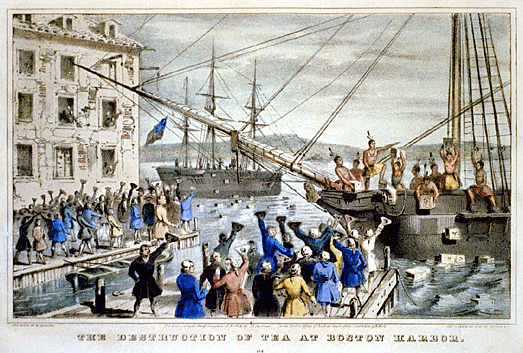
In 1833, 20-year-old Nathaniel Currier, now an accomplished
lithographer, moved from Boston to Philadelphia to do contract work for
M.E.D. Brown, a noted engraver and printer. Brown hired Currier to
prepare lithographic stones of scientific images for the American
Journal of Sciences and Arts. After completing the contract work in
1834, Currier traveled to New York City to work once again for his
mentor John Pendleton, who was now operating his own shop located at 137
Broadway. Soon after the reunion, Pendleton expressed an interest in
returning to Boston and offered to sell his print shop to Currier.
Currier didn’t have the resources to buy the shop, but he found another
local printer by the name of Stodart and together they bought
Pendleton's business.
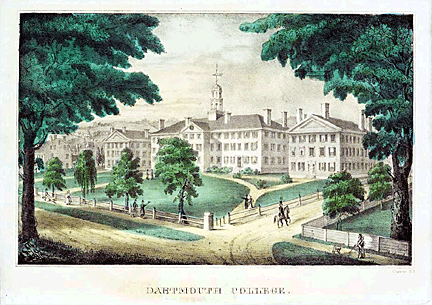 The
firm ‘Currier & Stodart' specialized in "job" printing. They produced
many different types of printed items, most notably music manuscripts
for local publishers. By 1835, Stodart was frustrated that the business
wasn’t making enough money and he ended the partnership, taking his
investment with him. With little more than some lithographic stones, and
a talent for his trade, Currier set up shop in a temporary office at 1
Wall Street. The
firm ‘Currier & Stodart' specialized in "job" printing. They produced
many different types of printed items, most notably music manuscripts
for local publishers. By 1835, Stodart was frustrated that the business
wasn’t making enough money and he ended the partnership, taking his
investment with him. With little more than some lithographic stones, and
a talent for his trade, Currier set up shop in a temporary office at 1
Wall Street.
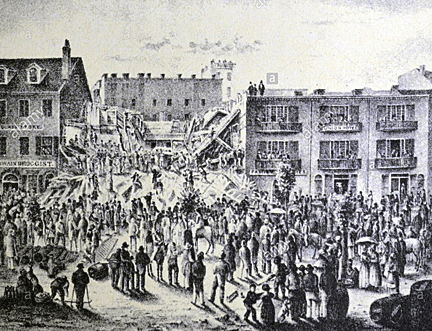 Currier
continued as a job printer and duplicated everything from music sheets
to architectural plans. He experimented with portraits, disaster scenes
and memorial prints, and anything that he could sell to the public from
tables in front of his shop. During 1835 he produced a disaster print,
“Ruins of the Planter's Hotel, New Orleans, which fell at two O'clock on
the Morning of the 15th of May 1835, burying 50 persons, 40 of whom
Escaped with their Lives.” The public had a thirst for newsworthy
events, and since newspapers of the time didn’t include pictures,
Currier gave the public a new way to "see" the news. Currier
continued as a job printer and duplicated everything from music sheets
to architectural plans. He experimented with portraits, disaster scenes
and memorial prints, and anything that he could sell to the public from
tables in front of his shop. During 1835 he produced a disaster print,
“Ruins of the Planter's Hotel, New Orleans, which fell at two O'clock on
the Morning of the 15th of May 1835, burying 50 persons, 40 of whom
Escaped with their Lives.” The public had a thirst for newsworthy
events, and since newspapers of the time didn’t include pictures,
Currier gave the public a new way to "see" the news.
Although the portrayal of the Steamboat Lexington launched his career,
Nathaniel Currier's earliest disaster print is believed to be the Ruins
of the Planter's Hotel, New Orleans. Currier also experimented with
portraits and memorial prints, including a tribute to President William
Henry Harrison, who died in office in 1841.
James Ives—Bookkeeper
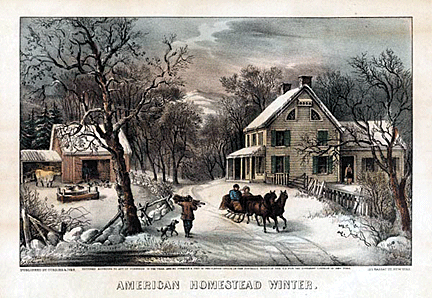 The
success of the Lexington print launched his career nationally. In 1841,
he hired James Ives, the 21-year- old brother-in-law of his brother
Charles. A native New Yorker, Ives was a self-taught artist and
professional bookkeeper. Ives quickly set out to improve and modernize
Currier’s bookkeeping methods. He reorganized the firm's sizable
inventory, and used his artistic skills to streamline the firm's
production methods. Currier taught Ives the lithography trade. The
success of the Lexington print launched his career nationally. In 1841,
he hired James Ives, the 21-year- old brother-in-law of his brother
Charles. A native New Yorker, Ives was a self-taught artist and
professional bookkeeper. Ives quickly set out to improve and modernize
Currier’s bookkeeping methods. He reorganized the firm's sizable
inventory, and used his artistic skills to streamline the firm's
production methods. Currier taught Ives the lithography trade.
Currier also hired his artistically inclined brother, Lorenzo, to travel
west and make sketches of the new frontier as material for future
prints. Charles worked for the firm on and off over the years, and
invented a new type of lithographic crayon which he patented and named
the Crayola.
By 1857, Currier had become so dependent on Ives’ skills and initiative
that he offered him a full partnership in the firm and appointed him
general manager. The two men chose the name ‘Currier & Ives' for the new
partnership, and became close friends.
Prints for the People
Promoting themselves as “Publishers of Cheap and Popular Pictures,”
Currier & Ives sold prints, which they advertised as “colored engravings
for the People," ranging from 20 cents to $6, depending on the size and
subject matter. Larger prints sold for $3 to $6.
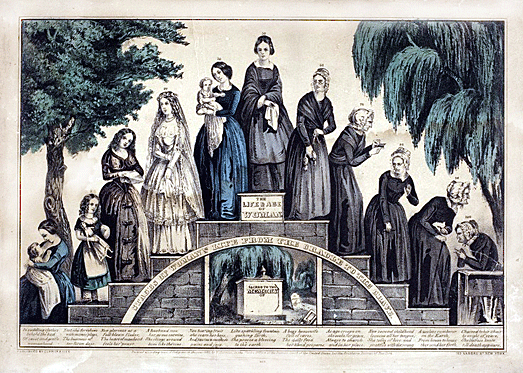
Customers could select prints from large
bins that lined the inside walls of their Nassau Street store. They
wholesaled smaller prints to peddlers and other outlets for as little as
6 to 12 cents each. Over the years the print sizes varied from just
under 3 x 5 five inches to 18 x 27 inches and larger. Topics could be as
mundane as fruits and flowers or as current as the Civil War and scenes
of the Wild West.
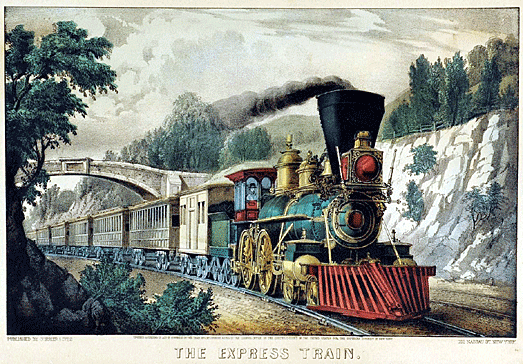
Since neither Currier or Ives were
professional artists, they purchased drawings from others for $1 to $10.
There were countless artists. Some remain unknown. Among the most
prolific artists were Francis Flora (Fanny) Palmer, Louis Maurer, A.F.
(Arthur Fitzwilliam) Tait and Thomas Worth.
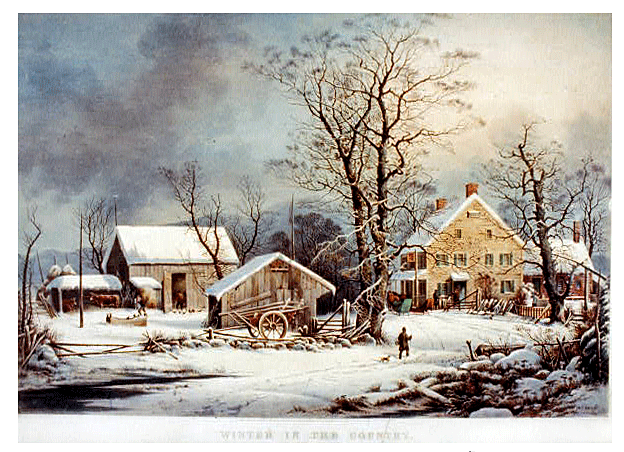
Part of the their great appeal of Currier
and Ives prints in the second half of the 19th-century was their
coloring. Typically, talented artists prepared original drawings, which
others then transferred to stone lithographs. Additional workers finally
hand-colored the prints.
The company's lithographic process first produced a black and white
image, which was later colorized in assembly-line fashion.
Currier & Ives first produced their prints as a black and white
lithographic image in a building at 33 Spruce Street in Philadelphia
where they occupied the third, fourth and fifth floors. Hand-operated
printing presses occupied the third floor. The fourth floor found the
artists, lithographers and the stone grinders at work. The fifth floor
housed the coloring department.
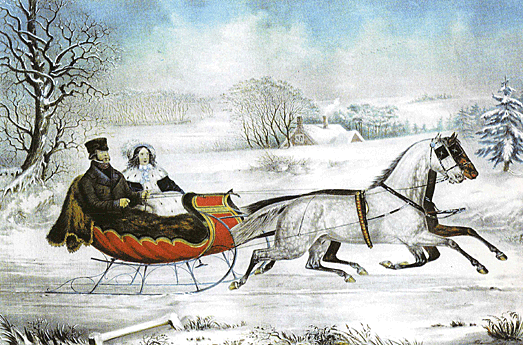
The colorists, mostly German immigrant girls, came to America with some
formal artistic training. Currier & Ives paid these colorists $1 per 100
small folios (a penny a print) and $1 per one dozen large folios. Each
colorist added a single color to a print. As a colorist finished
applying their color, she passed the print down the line to the next
colorist to add their color. The colorists worked from a master print
displayed above their table, which showed where to place the proper
colors. A touch-up artist sat at the end of the table, checking the
prints for quality and touching-in areas that may have been missed as
the print passed down the line. During the Civil War, demand for prints
became so great that Currier and Ives developed coloring stencils to
speed up production.
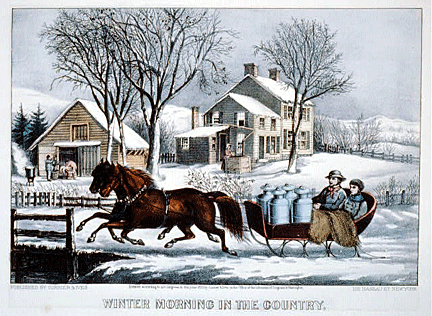 The
partners seldom identified the artists on the prints, themselves.
Exceptions were the legendary Thomas Nast, George Henry Durrie, who
specialized in travel and sporting scenes, and Francis Flora Palmer. She
came to the United States from England in 1840 and became one of Currier
and Ives' most prolific artists. During her first year she turned out 12
full renderings, and between 1860 and 1868, she was credited with more
than 100 lithographs, including “Sleepy Hollow Church,” “ The Village
Blacksmith,” “Early Winter,” “The Rocky Mountains,” and “Wooding Up on
the Mississippi.” The
partners seldom identified the artists on the prints, themselves.
Exceptions were the legendary Thomas Nast, George Henry Durrie, who
specialized in travel and sporting scenes, and Francis Flora Palmer. She
came to the United States from England in 1840 and became one of Currier
and Ives' most prolific artists. During her first year she turned out 12
full renderings, and between 1860 and 1868, she was credited with more
than 100 lithographs, including “Sleepy Hollow Church,” “ The Village
Blacksmith,” “Early Winter,” “The Rocky Mountains,” and “Wooding Up on
the Mississippi.”
The basic routine never varied although the topics would range from
“Trolling for Blue Fish” to the “Kiss Me Quick” romance of a young
couple. And the combination seldom failed.
In 1872 the Currier and Ives catalog proudly proclaimed:"... our Prints
have become a staple article... in great demand in every part of the
country... In fact without exception, all that we have published have
met with a quick and ready sale."
Currier finally retired in 1880, and Ives ran the business until his
death in 1895.
<
Back to More Antique Spotlights
Next Article > |
